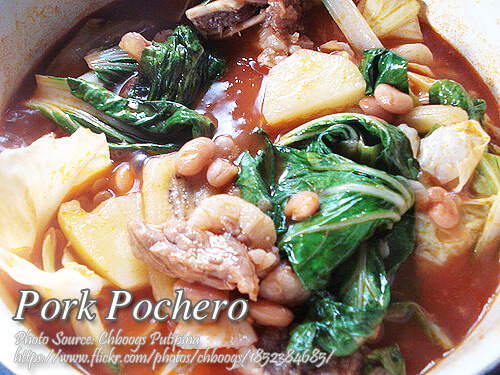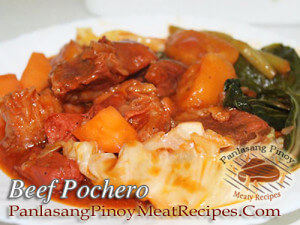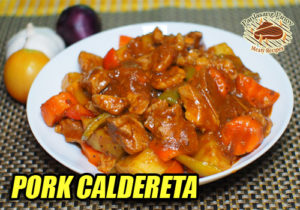Pork pochero is one of the variations of beef or chicken pochero and it is one of the popular Filipino tomato based meat stew. Usually when we cook pork pochero we use pork tenderloin which I think is more healthier than pork belly but it is more pleasing and tasty because of the tasty tender pork fat of the pork belly. It is also cheaper than tenderloin.
Also, most of the recipes I saw online uses garbanzos or chick peas but this version, which I think is more traditional used white beans, which are sold dried and you have to soak it in water overnight before cooking. I think there is a simpler way of preparing white beans, I think canned pork and beans will do the trick. But since it is already cooked, you have to add it when the pochero is almost cooked and all the ingredients are already combined.
Pork Pochero: A Heartwarming Filipino Stew to Bring Everyone Together
Whenever I think of pork pochero, I can’t help but remember lazy Sunday afternoons at my grandmother’s house in Bulacan. The kitchen was always alive with the aroma of garlic sizzling in oil, a sure sign that something special was in the works. This recipe, in particular, was a family favorite. It wasn’t just the hearty flavors of tender pork belly and sweet saba bananas that made it special—it was the love and care that went into preparing every single ingredient.
Over the years, I’ve taken bits and pieces of what I learned from my lola, my Tita Nena, and even my older brother, who once spent a summer working at a carinderia in Pampanga, to create my own version of pork pochero. This dish has a way of transporting me back to those carefree days, and I hope it does the same for you.
What Makes Pork Pochero So Special?
Pochero, often referred to as the Filipino version of the Spanish cocido, is a tomato-based stew brimming with tender meat, hearty vegetables, and a subtle sweetness from ripe saba bananas. Pork pochero, in particular, is a popular variation of this dish, offering a flavorful yet budget-friendly option compared to its beef counterpart.
My lola often said that the key to a good pochero lies in the balance of flavors. The savory notes of pork, the tanginess of tomato sauce, and the sweetness of bananas all work together to create a comforting dish that feels like a warm hug.
One unique feature of this recipe is the use of white beans. While many modern versions include garbanzos or chickpeas, my Tita Nena always insisted on soaking dried white beans overnight. She believed this extra step made the stew more authentic, as canned alternatives were a rarity in her younger years. Of course, if you’re pressed for time, canned pork and beans can work in a pinch—just add them towards the end of cooking to avoid over-softening.
How to Achieve Tender and Flavorful Pork
Choosing the right cut of pork is crucial. Pork belly is my go-to for this dish because its marbled fat renders beautifully during cooking, infusing the stew with rich, savory flavors. My brother, however, swears by pork tenderloin for a leaner option. Whichever you choose, the cooking technique remains the same.
Start by sautéing garlic and onions until they release their aroma. This step creates a fragrant base that lays the groundwork for the stew’s depth of flavor. Adding patis, or fish sauce, while stir-frying the pork belly enhances the umami, ensuring every bite is seasoned to perfection.
Simmering the meat in tomato sauce and water is another critical step. The low-and-slow cooking process allows the pork to become irresistibly tender while the tomato sauce melds with the savory stock. Don’t forget to skim off any scum that floats to the top—this keeps the broth clear and free from impurities.
A Symphony of Vegetables and Bananas
What makes pork pochero truly stand out is its medley of vegetables and saba bananas. Potatoes, green beans, cabbage, and pechay are classic additions that add texture and vibrant color to the dish. The saba bananas, however, are the real stars.
Saba bananas lend a subtle sweetness that balances the tangy tomato base. My cousin Lito, who now lives in Cebu, told me that his favorite pochero memory was biting into a perfectly cooked saba that had soaked up all the stew’s delicious flavors. “It’s like dessert in the middle of a meal,” he’d joke.
For best results, add the bananas and leafy greens towards the end of cooking. This ensures they retain their texture and don’t turn mushy.
A Dish Steeped in History
Pochero is a dish that speaks of the Philippines’ colonial past, with its roots tracing back to Spanish cocido. Over time, Filipinos added local ingredients like saba bananas and patis, giving the dish its unique identity. It’s a testament to how we’ve made something foreign our own, much like many other Filipino dishes.
My Tita Nena often shared stories of how pochero was considered a “fiesta dish” in her youth, reserved for special occasions because of its premium ingredients. These days, it’s become more accessible, yet it still retains that festive, celebratory spirit.
Enjoying Pork Pochero Today
Cooking the pork dish may take some time, but the effort is well worth it. There’s something magical about gathering around the table with family, sharing stories and laughter over a steaming bowl of this comforting stew.
Whether you’re new to Filipino cooking or a seasoned pro, pork pochero is a dish that’s sure to win hearts. Its hearty flavors, colorful ingredients, and nostalgic appeal make it a meal to remember. As I serve this dish to my own family now, I can’t help but feel a connection to those who came before me, passing down not just recipes but also the love and care that make them truly special.
So why not give it a try? Who knows—it just might become a family tradition in your home too.
How to Cook Pork Pochero
Ingredients
- 1 kilo pork belly liempo, remove the skin and slice into serving pieces
- 1/2 head garlic chopped
- 1 pc medium size onion chopped
- 4 pcs. saba bananas sliced diagonally
- 2 pc small size potato quartered
- 100 grams green beans trimmed
- 1/2 small cabbage quartered
- 1 bunch pechay or bok choy optional
- 1/8 cup patis or fish sauce
- 1 cup dried white beans soak in water overnight
- 1/2 cup tomato sauce
- 1 Tbsp. peppercorns
- salt to taste
- cooking oil
Instructions
How to cook Pork Pochero:
- In a medium size pan, saute garlic and onions until fragrant. Then add the pork belly and stir fry for about 3 minutes or until the pork sizzles.
- Then add the patis and tomato sauce. Stir for a few minutes then add the 3 cups of water, white beans and peppercorns.
- Bring to a boil then simmer for 20 to 30 minutes or until the pork and the white beans are tender. Remove the floating scum and add more water if the soup stock is drying up.
- When pork is tender, add in the potatoes and cook for 3 minutes more or until the potatoes are tender.
- Then add in the green beans, cabbage, pechay and saba bananas and cook for 3 to 5 minutes more.
- Adjust the seasoning and add more salt if necessary. Serve hot.
Notes
Cooking Tips:
Choose the Right Cut of Pork
For the best flavor and texture, use pork belly when making this pochero. Its marbled fat renders beautifully during cooking, infusing the stew with richness and tenderness. If you prefer a leaner option, pork tenderloin works too, but you may need to adjust the cooking time to avoid drying it out.Balance Your Flavors
The secret to a perfect pochero lies in balancing savory, tangy, and sweet flavors. Use patis to enhance the umami, tomato sauce for the stew's signature tang, and saba bananas to add natural sweetness. Taste and adjust the seasoning as you go to ensure every bite is harmonious.Add Vegetables and Saba Bananas at the Right Time
Timing is crucial to prevent the vegetables and saba bananas from overcooking. Add hearty vegetables like potatoes early in the simmering process to let them absorb the flavors. Leafy greens and bananas should go in during the last few minutes to keep their vibrant color and firm texture.





